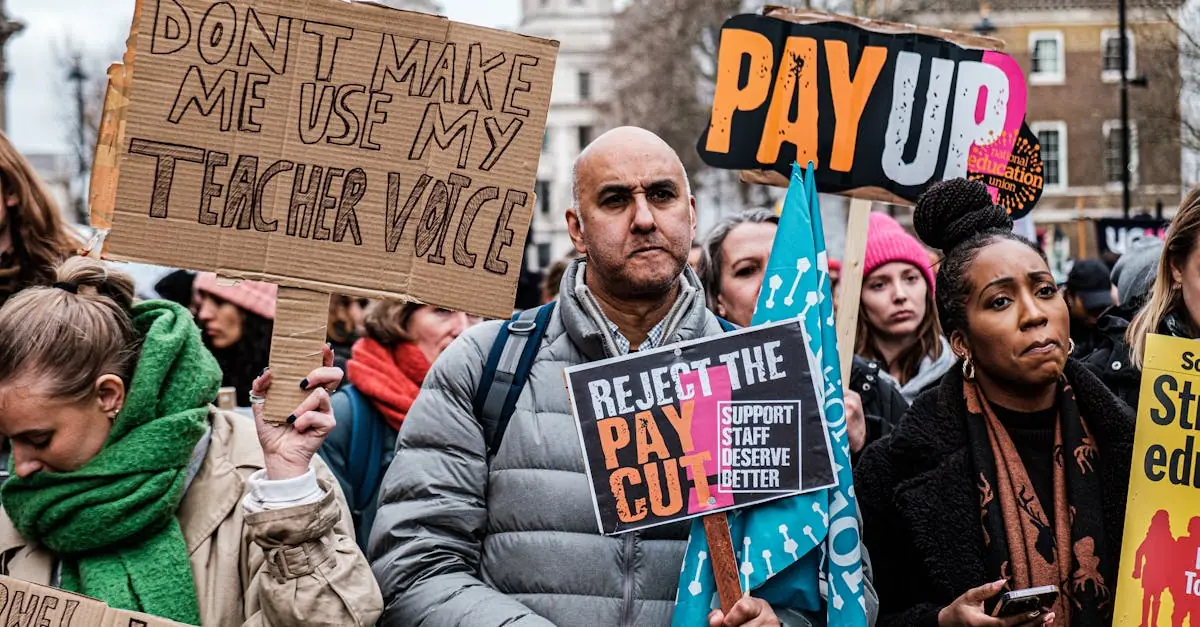In the colorful world of public education, the terms equality and equity often engage in a fierce tug-of-war. On one side, equality insists that every student should get the same resources, like a classroom full of identical desks and textbooks. On the other hand, equity argues for a more tailored approach, ensuring that every student receives what they truly need to thrive—because let’s face it, not every kid learns best sitting on a one-size-fits-all desk.
As schools grapple with these concepts, the question becomes: how do they strike a balance? It’s a bit like trying to bake a cake without a recipe—everyone has their own ideas, and sometimes it gets messy. In this article, we’ll explore how educators can navigate the complexities of equality and equity, ensuring that every student gets a fair shot at success, even if it means breaking out the measuring cups and flour.
Table of Contents
ToggleUnderstanding Equality and Equity in Education
Understanding equality and equity in education requires grasping their distinct definitions and historical implications. Both play crucial roles in shaping educational policies and practices today.
Definitions of Equality and Equity
Equality refers to providing every student with the same resources and opportunities. In contrast, equity focuses on offering tailored support that considers individual circumstances and needs. Recognizing the difference is vital; equality often assumes a level playing field, while equity acknowledges existing disparities among students. Equity aims to address and mitigate those disparities, ensuring all students receive what they require to succeed.
Historical Context of Equality in Education
Historically, equality in education emerged from civil rights movements, aiming to eliminate discrimination and provide access to schooling for marginalized groups. Legal decisions, such as Brown v. Board of Education in 1954, played a significant role by declaring segregated schools unconstitutional. Progress followed these milestones, leading to policies aimed at ensuring equal access. However, systemic inequalities still persist, highlighting the ongoing need for a focus on equity within educational systems. These historical developments showcase the evolution of educational equality, revealing gaps that equity strategies must address today.
The Importance of Equity in Public Education
Equity plays a crucial role in shaping public education, particularly in addressing the varying needs of students. Understanding socioeconomic factors provides insight into how educational outcomes can differ significantly among students.
The Role of Socioeconomic Factors
Socioeconomic status directly influences access to educational resources. Students from low-income families may lack essential resources like tutoring or technology, hindering academic performance. Research shows that disparities in funding often correlate with neighborhoods. Schools in affluent areas typically receive more financial support compared to those in economically disadvantaged regions. Consequently, implementing equity-focused funding strategies can help bridge this gap, ensuring all students receive adequate opportunities.
Impact on Diverse Student Populations
Diverse student populations face unique challenges within the education system. Cultural backgrounds, language barriers, and differing learning styles significantly affect educational experiences. Providing support tailored to these variations enhances learning and promotes inclusivity. For instance, offering bilingual education can help non-native English speakers excel. Additionally, recognizing and respecting various cultural perspectives fosters a more welcoming environment. Equity measures that address these factors contribute to improved academic outcomes for all students, particularly those from marginalized groups.
Strategies for Reconciling Equality and Equity
Balancing equality and equity in public education requires practical strategies. Policymakers and educators must work together to align their approaches effectively.
Policy Reforms and Best Practices
Implementing policy reforms enhances equity in education. States can adopt funding formulas that distribute resources based on student needs instead of merely student counts. Research points to weighted funding models, which allocate additional resources for students from low-income backgrounds or those needing special education. These practices help create more equitable learning environments. Educators can also embrace evidence-based pedagogical practices tailored to diverse student profiles. This includes differentiated instruction and universal design for learning principles that accommodate varying learning styles. Regular assessments can inform instructional adjustments, ensuring that every student receives appropriate support.
Community Engagement and Support
Engaging communities strengthens equity initiatives in education. Schools can forge partnerships with local organizations to provide resources like tutoring, mentoring, and after-school programs. These collaborations broaden access to essential supports, especially for marginalized students. Parent and community feedback can guide school practices and policies, ensuring they meet the actual needs of students. Promoting cultural competency among educators fosters inclusivity, making diverse families feel valued within the school community. Active participation from families creates a sense of ownership and accountability, which ultimately enhances equity in public education.
Challenges in Achieving Balance
Numerous challenges hinder the balance between equality and equity in public education today.
Systemic Barriers to Equity
Systemic barriers persist across school systems, impacting equitable access to resources. Funding disparities arise from socio-economic factors, where schools in affluent areas receive greater financial support than those in low-income neighborhoods. Additionally, inadequate infrastructure often prevents schools from developing programs that cater to diverse student needs. Students facing language barriers grapple with limited access to bilingual education and other necessary support. Research shows that marginalized groups experience increased difficulty in accessing quality education, perpetuating inequities within the system.
Resistance to Change within Educational Systems
Resistance to change complicates efforts to achieve educational equity. Many educators and administrators favor traditional methods, fearing new approaches might disrupt established practices. Furthermore, skepticism about the effectiveness of equity-focused strategies can stall implementation. Some policymakers struggle with reallocating resources to address the needs of disadvantaged students due to pressure from stakeholders who prioritize equality. Opposition often stems from a reluctance to challenge the status quo, stifling innovation in education systems. Ultimately, overcoming this resistance is crucial for fostering an equitable educational environment.
Reconciling equality and equity in public education is a complex yet essential endeavor. It requires a commitment to understanding the unique needs of each student while also striving for a fair distribution of resources. By implementing equity-focused strategies and fostering community partnerships, educators can create an inclusive environment that supports all learners.
Addressing systemic barriers and embracing innovative approaches will be key to advancing educational equity. As schools continue to navigate these challenges, the goal remains clear: to ensure that every student has the opportunity to succeed, regardless of their background or circumstances.




